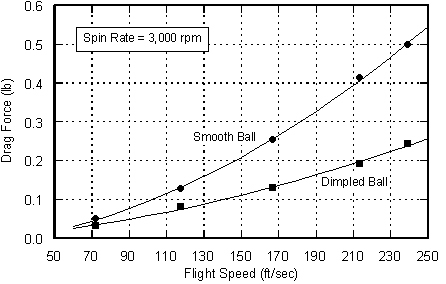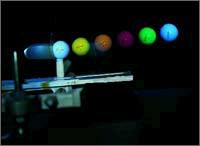| |
     


|
We Accept Check or Charge Cards
 |
|
 |
|
 |
|
|
|
 |
|
|
|
The Evolution of Golf Balls
Golf Ball
Evolution - Welcome to Your
Golf Headquarters
|
|
|
|
|
|
|

|
|
|
|
| |


|
| |
Golf ball
aerodynamics is one of the most pervasively misunderstood (or just
un-understood) technical subjects in the game. Not that there's a
shortage of "experts", there's just a shortage of actual knowledge.
Misinformation rules in print and broadcast media, advertising, and
sometimes even in technical documents like patents. Here are some of
the more common misconceptions, along with the truth. |
| |
|
| |
Myth: Dimples give the ball
"traction" on the air.
Sort of like a
snow tire? This is one which appeals to our common sense notions
about airflow. Unfortunately, common sense is often wrong about
aerodynamics, and that's the case here. Truth #1 taken from Intro to
Aerodynamics I: When a golf ball or any other solid object moves
through the atmosphere, a thin layer of air (the boundary layer)
sticks to it and is dragged along with it. There is no slipping
between the object and the air. Therefore, the issue of "traction on
the air" is completely irrelevant and without a shred of meaning.
Slipping never occurs, no matter how smooth and slick the surface of
the ball may be. |
| |
|
| |
Myth: Dimples create lift
Amazing but true:
A smooth golf ball will only fly about half as far as one with
dimples. But why does this happen? Many a golf ball guru would
explain that a ball without dimples creates no lift. But more than
250 years ago, B. Robins was able to demonstrate the lift force on a
spinning dimpleless musket ball. And any serious table tennis match
will provide example after example of wildly curving, floating, or
diving shots produced by lift forces acting on spinning smooth
balls. The common factor here is spin, not dimples. As we saw above,
it's the spinning action of the ball which warps the airflow and
makes the ball act like a wing.
This is not to say that dimples have no effect on lift. To the
contrary, they can affect both the amount and the direction of the
lift, especially at low speeds.
 |
| |
Lift Force on
Smooth and Dimpled Golf Balls
|
| |
The graph shows
the lift forces measured in a wind tunnel on both a smooth golf ball
and a dimpled one at identical spin rates of 3,000 rpm (a typical
value for the first part of a drive). While the smooth ball doesn't
generate as much lift as the dimpled one, it does create a
substantial amount - equivalent to about 1/3 to 1/2 of its own
weight for much of the speed range. So in reality, it's the spin
that creates the lift. The dimples just tailor the lift to be more
useful for a golf ball.
While the improved lift on a dimpled ball is part of the reason for
the extra distance, that's not the whole story. It's not even most
of the story. As we've seen above and will verify below, the dimples
cut the drag, which pays off even bigger. |
| |
|
| |
Myth: Dimples increase the drag
 |
| |
Drag Force on
Smooth and Dimpled Golf Balls
|
| |
It is often said
that dimples increase the drag on the ball, but since they are
necessary to create the lift, the tradeoff is worth it. Your average
Joe Golfer would accept this at face value because it agrees with
(guess what?) our common sense. A smooth ball would slide through
the air with less friction, right? So a dimpled ball would have more
air friction, and thus more drag. Makes sense. Unfortunately, it's
completely wrong.
First, as we have discovered, the dimples don't create the lift,
they only improve it. And second, as shown in History of the Golf
Ball, Aerodynamics, the dimples substantially reduce the drag by
creating a turbulent boundary layer which reduces the wake. Wind
tunnel tests verify this, as shown in the graph above. Measured drag
forces for a smooth and a dimpled golf ball are compared throughout
the full speed range. Clearly, the dimpled ball generates much less
drag, only about half as much as the smooth one. This drag reduction
is the most important contribution of the dimples. Strike two for
common sense. |
|
|
|
Myth: Large, shallow dimples make a ball fly higher.
This notion is only half wrong. It probably traces back to the early
1970s, when the so-called "Big Dimple" Titleist was introduced. This
ball had a noticeably higher trajectory than many of its
contemporaries, and its novel dimple pattern had noticeably large
and shallow looking dimples, and thus was made the connection. But
the truth is somewhat different: All else being the same, its true
that shallower dimples will generally make a golf ball fly higher.
But larger dimples will actually make it fly lower. Why, then, was
the "Big Dimple" Titleist a high flier? Because even though the
dimples were large, they were also very shallow for their size,
shallow enough that the net result was a higher trajectory.
|
|
|
|
Myth: More dimples make a longer ball.
In 1983, Titleist introduced the 384 Tour, a new generation ball
which had 60 more dimples and, for many golfers, significantly more
distance than its predecessor. This ignited a "dimple war" in the
industry, when many companies' marketers went for the easy sell with
"more dimples = more distance" campaigns. If this sounds entirely
too easy (Want more distance? Just put more dimples on the ball . .
. ), well, it is. Just a little thought will reveal that it doesn't
even make sense. If it were true, then thousands of tiny dimples
would make a very long ball. And millions of microscopic dimples
would let anyone reach par fives in one. But aren't these balls
becoming more like smooth balls? We already know that smooth balls
only go about half the distance of dimpled ones.
The truth is that the number of dimples is not a very important
parameter. Any number from around 300 to around 500 works quite
well. It's far more important to carefully optimize the dimensions
of the dimples to provide the desired lift and drag characteristics.
|
|
|
|
Myth: Golf balls lose distance in humid air.
This is another one that is easy to believe because it agrees with
our common sense. Humid air feels heavy, and therefore the ball
should have a tougher time punching through it. But in truth, humid
air is actually lighter than dry air, and the ball will actually fly
farther. Strike three. But don't bother seeking out muggy days to do
a John Daly impression, because the advantage is truly minuscule.
The best one could hope for would be a gain of about 18 inches.
|
|
|
|
Myth: Put overspin on the ball for more distance.
There are television golf commentators who time and again will
attribute a particularly long carrying and/or rolling shot to the
player "putting a lot of overspin on the ball." This is utter
nonsense for two reasons: first, it is impossible to put any
overspin on any shot other than a cold-topped one, and second, even
if it could be done, the shot would be much shorter than one with
backspin. With overspin, the lift force, which normally helps hold
the ball in the air against gravity, reverses and helps gravity pull
the ball down. Such a shot would only fly a small fraction (perhaps
1/4) of the normal distance, and even with a lot of extra roll will
still wind up short by about half. |
|
|
|
Myth: A golf ball should generate maximum lift and minimum drag.
Guess what? Another appealing notion, and another wrong one. A well
engineered golf ball creates the correct amount of lift and drag to
achieve the desired trajectory shape while maximizing distance. A
blind pursuit of maximum lift and minimum drag will usually produce
a very high flying ball with an annoying affinity for the dreaded
upshoot. Given the right conditions, such balls can achieve a carry
distance improvement, but it comes at the cost of wind-performance
you wouldn't wish on your favorite sandbagger And the loss of roll
distance brought on by the high trajectory usually means that the
total distance is no better, and often worse.
|
|
| |

Golf Ball Evolution -
Epilogue
|
|
|
|
|
|
|



To beginners and pros alike, the flight of a smartly struck golf
ball is a thing of beauty, marvelous to behold and boosting to the
ego. No matter how badly we might play on any given day, no matter
how many three-putts in a round, it's that one purely struck shot
that keeps us coming back for more. If this is the addiction of
golf, then dimples must bear the shame. Without them, we wouldn't
bother. |
|
|
|
| |
|
|
|
|
|
|
|
|

|
|
|
 >
>
![]()







